Abstract
Network space allows participants to implement professional and educational tasks, find their friends and professional colleagues. Virtual space has a large amount of information that can meet the needs of different groups, depending on the actual tasks of each period. Social networks are increasingly gaining popularity among people of different ages. Of course, there are certain features of the network interaction of users of different ages, related to the goals, attitudes and strategies of network activity. The article compares the features of electronic communication of participants in social networks of early and middle adulthood. The results of empirical research show that representatives of early adulthood demonstrate a greater sense of social comfort in network communication. The desire to realize the ideal «true self» is not the only regulator of the behaviour of participants in this sample. The feeling of loneliness and obsessive thoughts about the Internet are typical for representatives of different ages with minimal differences. Respondents of early adulthood are more likely to seek their identity. They are aimed at acquiring new experience in virtual communication. Young people are more inclined to express social and role components, search for emotional support, help in experiencing loneliness, desire for self-expression and self-presentation than mature users of the social network. The sample of users of early adulthood was more likely to demonstrate a strategy for an active status variation of roles than users of average adulthood.
Keywords: Electronic communicationattitudesnetwork activityvirtual self-presentation
Introduction
In the modern world, electronic communication is understood as communication in the global information environment, which arose from the combination of many personal computers into one single network and characterized by the creation of a specific communicative environment. Virtual communicative environment is a special communicative space that is formed by a stable set of certain factors and conditions of communication .
At this stage of the development of the World Wide Web, the active integration of people into social networks becomes very important and already «classical». Against this background, Internet communities such as social networks and a variety of microblogs have gained considerable popularity in the world today. The most popular networks in the world are Facebook and Twitter, in Russia – VKontakte and Odnoklassniki.
Problem Statement
The controversial issue for today is how social networks influence the process of communication between people. On the one hand, social networks really make it easier to maintain relationships, expand opportunities for new acquaintances, find friends or work. However, on the other hand, social networking can also cause a number of other problems, such as the loss of users from reality, from interaction with the family, instead of which a person spends his free time at home at the computer, there may also be a lack of live, real communication (Filipkowsk, & Smyth; 2012). Often, users of social networks spend a considerable amount of time on virtual communication with strangers, which can adversely affect their studies, work or personal life.
Teenage and youth audiences in modern society are exposed to quite a strong influence from the media, because of which both personal attitudes and typical behavioural patterns are being transformed. Information technologies give different groups the opportunity to create a field of an autonomous subculture that can give both models of socially approved and socially disapproved behaviour, and thus influence the style of self-presentation of the individual (Sivunen & Hakonen; 2011).
A large number of authors singled out negative features of social networks. So, often enough users on their accounts upload an excessive amount of personal information and photos. They are not always able to understand the measure of the frankness of their statements.
Another urgent problem of using social networks is dependence on them, which in its essence is much stronger than from conventional computer games. This is due in large part to the fact that the time a young man can spend visiting his friends' pages, spreading and commenting on his photos, just communicating is much more than what can be spent on the game.
The most popular social networks, such as Facebook, Odnoklassniki and VKontakte, force users to create a certain ideal image of themselves. Young people, after creating their own ideal image on the network, begin to build their identity in such a way that it fully meets their virtual image. Most young men and women are engaged in more or less self-knowledge, spreading on their pages in social networks certain photos, pictures or text material - exactly what they would like to demonstrate to the world and whom they would like to appear (Cheek & Briggs; 1982). Thus, some ideal image of oneself is formed with the help of social networks. Social networks indulge the desire to look in the best light and give the opportunity to submit themselves as profitable as possible. A new, «ideal» personality, which is created by a young man in a virtual world, can soon begin to have an impact on a real person. This phenomenon is explained by the fact that in social networks, users have the opportunity to see only the «virtual» side of a person's identity, and begin to react solely to it.
Research Questions
The Internet has completely changed the nature of the person's activities and communication. A growing number of people are actively involved in networking every year. This applies to both the professional sphere and everyday communication. Currently, the Internet is able to meet most of the human needs, it provides a huge number of opportunities for self-realization and communication (Renninger & Shumar, 2002). The use of social networks is one of the most common ways of communication in cyberspace. Social networks are gaining popularity among people of all ages. Pre-schoolers, schoolchildren, young people, mature and elderly people are beginning to actively engage in Internet communication and use a variety of services provided by the network. There are certain features of electronic communication of active participants of network interaction of different ages, connected with the goals, attitudes and strategies of network activity.
Purpose of the Study
The research problem is that virtual communication implies the inclusion of a huge number of users of different ages in the Internet interaction. Each age audience is characterized by certain information preferences, motives for using network resources, strategies for behaviour on the Internet, attitudes towards the Web.
The purpose of our research is to reveal the features of electronic communication of users of social networks of early and middle adulthood.
The research problem is that virtual communication implies the inclusion of a huge number of users of different ages in the Internet interaction. Each age audience is characterized by certain information preferences, motives for using network resources, strategies for behavior on the Internet, settings for the Web.
The purpose of our research is to reveal the features of electronic communication of users of social networks of early and middle adulthood.
G. Kreig determines «Early adulthood» as 20-40 years. The main tasks of this age are to achieve proximity and identity. An important place is the desire for deep emotional intimacy with meaningful. The motivational sphere of early adulthood lies in the field of choosing a professional path, creating a family. The choice of profession is based on independent conclusions. Parental attitudes and practical considerations are reduced as a significant factor. At the forefront is the desire to have fun and a sense of self-fulfilment from the chosen profession. According to the periodization of G. Kraig, the age of 40-60 years is called «average adulthood». A person already has a great professional and life experience. Children become more independent, communication with them is also undergoing changes. According to G. Kreig, a person in a period of average adulthood acquires a state of wisdom, which is expressed in the ability to assess information in a more global context and the ability to cope with uncertainty. At this age, adults often suffer from depression, are more prone to stress and sense of loneliness and experience a normative crisis of middle age. Changes occur in the motivational sphere. This manifests itself in the desire to act actively and receive an instant result and thus immediately meet the need. The basic needs of average adulthood include the realization of their creative potential, the need to transfer their experience to the younger generation, maintaining relationships with loved ones, forming a stable pace of life to prepare for a meeting of old age. As a result, there is a rethinking of life priorities, values in three spheres of life: professional, family and personal (Kreig, 2005).
Research Methods
The «Online behavior questionnaire» (A.E. Zhichkina) was used to study psychological strategies of network activity (Zychkina, 2001). Specificity of installations in the aspect of network interaction was studied using the questionnaire of the problematic use of the Internet (R. Davis in the adaptation of E. Gubenko) (Davis, 2001;
The features of self-presentation in Internet communication were identified using the questionnaire «I am in Internet communication» (I.S. Shevchenko) (Shevchenko, 2002). Methods of mathematical data processing: descriptive statistics, nonparametric statistics, correlation analysis. Software: Microsoft Word, Microsoft Excel, IBM SPSS Statistics Version 20.
The study involved 80 users of the social network VKontakte. They made up two age selections: 18-25 years and 40-53 years.
The average length of use of the computer by users of early adulthood is 11, 1 years; users of average adulthood - 15.5 years.
Findings
Here are the results of the comparative analysis by methods. Fig.
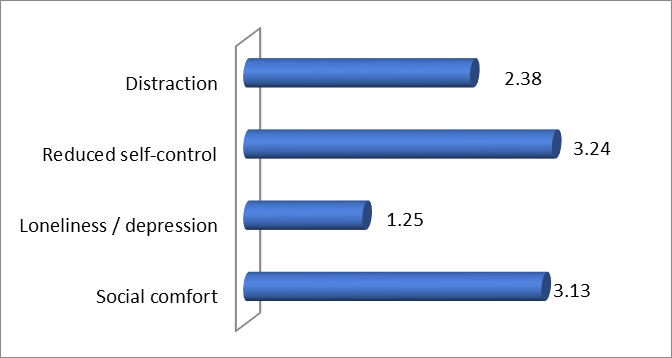
According to the data received, the dominant attitude in relation to the Internet among users of early and middle adulthood is «Reduced self-control», followed by «Social comfort», «Distraction» and «Loneliness / depression».
Mathematical processing by the criterion xr2-Friedman revealed significant differences in the distribution on scales (xr2 = 124.4, p =0.000). Participants of the study are often visited by obsessive thoughts about the Internet. They have an inability to reduce the time of using the Internet. They feel comfortable enough in communication in a social network that acts on a means of distraction from real problems, getting rid of loneliness or depressive manifestations.
On the histogram of Fig.
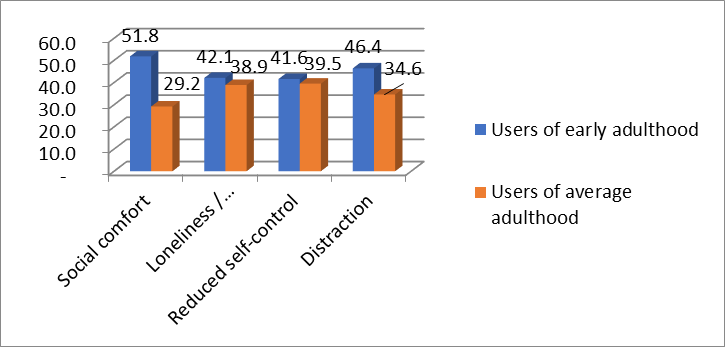
Fig.
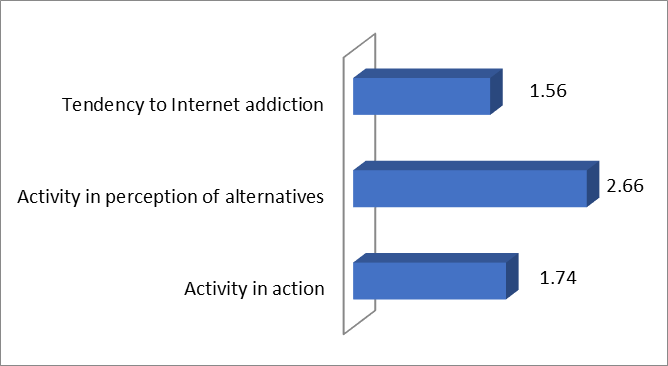
The dominant strategy for online behaviour among users of early and middle adulthood is «Activity in the perception of alternatives», followed by «Activity in Action» and «Addiction to Internet Addiction». The application of the xr2-Friedman criterion confirmed significant differences in the distribution of scales (xr2 = 60,855, p =, 000). Domination of the scale «Activity in perception of alternatives» is characteristic for those users whose desire to realize the ideal «Me» is not the only regulator of behaviour on the Internet.
Fig.
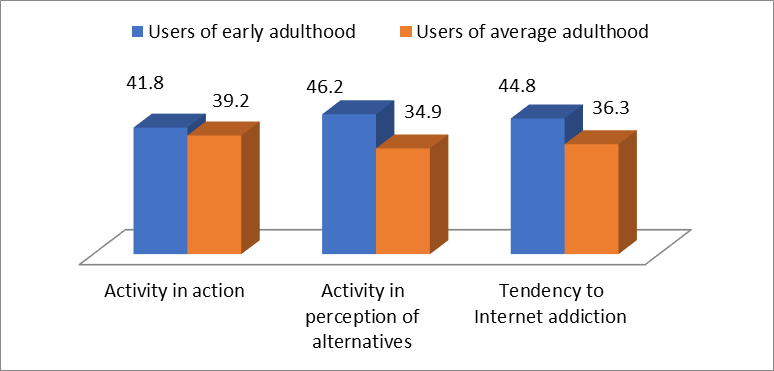
Fig.
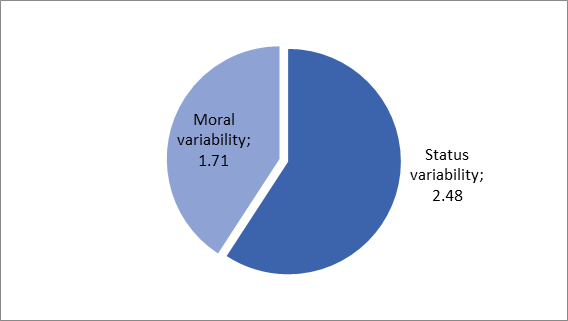
According to the xr2-Friedman criterion, significant differences were found on the scales of the questionnaire (xr2 = 32.568, p = 0.000). The dominant strategy is «Status Variability», i.e. the image of the «Me» of respondents is inherent in the manifestation of various social roles in a virtual environment.
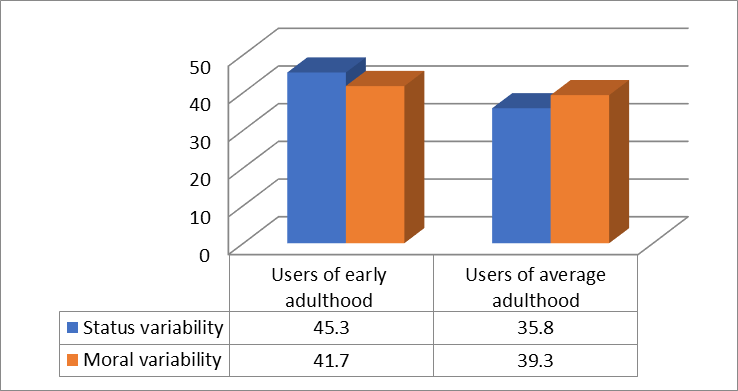
The Mann-Whitney criterion revealed significant differences in the «Status Variability» scale (U = 610, p = 0.055). Users of early adulthood are more likely to manifest social roles, use and vary their personal and social status and individual style on the Internet than adults.
The conducted correlation analysis of the results of the study using the Spearman correlation coefficient revealed the following significant relationships between the investigated parameters:
In the sample of users of early adulthood.
1) Between «Moral Variability» and « Tendency Internet Addiction» (rs = 0.316, p≤0.05). The more pronounced the manifestations of users to vary their moral position in the Internet space, the more inherent is the propensity to Internet-dependent behaviour.
In the sample of users of average adulthood.
1) Between «Social comfort» and «Tendency Internet addiction» (rs = -0.394, p≤0.05). For users of average adulthood, experiencing a sense of social comfort, satisfaction from network communication, there is no tendency for Internet addiction.
2) Between «Loneliness / Depression» and «Activity in Action» (rs = -0.313, p≤0.05), «Loneliness / Depression» and «Active in the perception of alternatives» (rs = -0.367, p≤0.05). Participants in social networking with a pronounced sense of loneliness or depression prefer to avoid active socially desirable behavior strategies on the Internet.
3) Between «Distraction» and «Internet addiction» (rs = -0,342, p≤0.05). The more the user strives to avoid the solution of important tasks or problems in reality with the help of the network, the less he has a tendency to Internet addiction. The communicative function of the Internet acts as a counterbalance to the development of symptoms of addiction.
4) Between «Status Variability» and «Internet Addiction» (rs = -0.322, p≤0.05). For users prone to Internet addiction is not characteristic of varying their personal and social status and individual style in a virtual environment.
Conclusion
Comparative analysis of samples by age shows a greater sense of social comfort on the Internet in representatives of early adulthood. The desire to realize the ideal "Me" is not the only regulator of the behaviour of representatives of this sample. A sense of loneliness and obsessive thoughts about the Internet are typical for representatives of both samples with minimal differences. Respondents of early adulthood are more likely to seek their identity. They are aimed at acquiring new experience in virtual communication. Young people are more inclined to express social and role component, search for emotional support, help in experiencing loneliness, desire for self-expression and self-presentation than mature users of the social network. The sample of users of early adulthood was more likely to demonstrate a strategy for an active status variation of roles than users of average adulthood.
Thus, at the current stage of development Internet technologies provide many opportunities for the activity of participants in virtual interaction. Network space allows participants to implement professional and educational tasks, find their friends and professional colleagues. The virtual space has a large amount of information that can meet the needs of different age groups, depending on the actual tasks of each period. Users of early adulthood get the opportunity of professional self-determination, access to educational resources and development of social contacts with real people. Users of average adulthood, for whom the Internet space is a new and less familiar medium for interaction, also receive many opportunities. The Internet acts for them as an environment where users move away from their daily problems, unsolved problems of age development.
References
- Cheek, J.M. & Briggs, S.R. (1982). Self-consciousness and aspects of identity. Journal of Research in Personality, 16(4), p. 401-408.
- Davis, R.A. (2001) A cognitive-behavioral model of pathological Internet use. Computers in Human Behavior, 17(2) 187-195. doi: 10.1016/S0747-5632(00)00041-8
- Gubenko E.A. The attitudes questionnaire toward the Internet. Retrieved from http://flogiston.ru/articles/netpsy/internet_questionary (31.05.18).
- Filipkowski, K.B. & Smyth, J.M. (2012). Plugged in but not connected: Individuals’ views of and responses to online and in-person exclusion. Computers in Human Behavior, 28, 1241-1253. doi:10.1016/j.chb.2012.02.007
- Kreig G. (2005) Developmental psychology. St. Petersburg: Peter.
- Renninger, K.A., Shumar, W. (2002). Building virtual communities: learning and change in cyberspace. Cambridge University Press.
- Shevchenko I.S. (2002) Variability of self-presentation of the person in Internet communication. (PhD thesis) Kazan.
- Sivunen, A., Hakonen, M. (2011). Review of virtual environment studies on social and group phenomena. Small Group Research, 42(4), 405-457. doi: 10.1177/1046496410388946
- Sungurova N., Karabuschenko N., Boguslavskaya D. (2017) Psychological strategy of network activity of students and their attitudes towards intern. In 4th International Multidisciplinary Scientific Conference on Social Sciences and Arts SGEM 2017 (Book 3, Vol. 2, pp. 287-292), Retrieved from www.sgemsocial.org, Book 3, Vol 2, p. 287-292.
- Zychkina A. E. (2001) Interrelation of the identity and behavior on the Internet of users of adolescence (Abstract of PhD thesis in Psychology). Moscow: MSU.
Copyright information

This work is licensed under a Creative Commons Attribution-NonCommercial-NoDerivatives 4.0 International License.
About this article
Publication Date
23 November 2018
Article Doi
eBook ISBN
978-1-80296-048-8
Publisher
Future Academy
Volume
49
Print ISBN (optional)
-
Edition Number
1st Edition
Pages
1-840
Subjects
Educational psychology, child psychology, developmental psychology, cognitive psychology
Cite this article as:
Sungurova, N. L., Karabuschenko, N. B., Khvorova, E. M., & Boguslavskaya, D. G. (2018). Features Of Electronic Communication In Social Networks Of Users Of Different Ages. In S. Malykh, & E. Nikulchev (Eds.), Psychology and Education - ICPE 2018, vol 49. European Proceedings of Social and Behavioural Sciences (pp. 650-658). Future Academy. https://doi.org/10.15405/epsbs.2018.11.02.75

